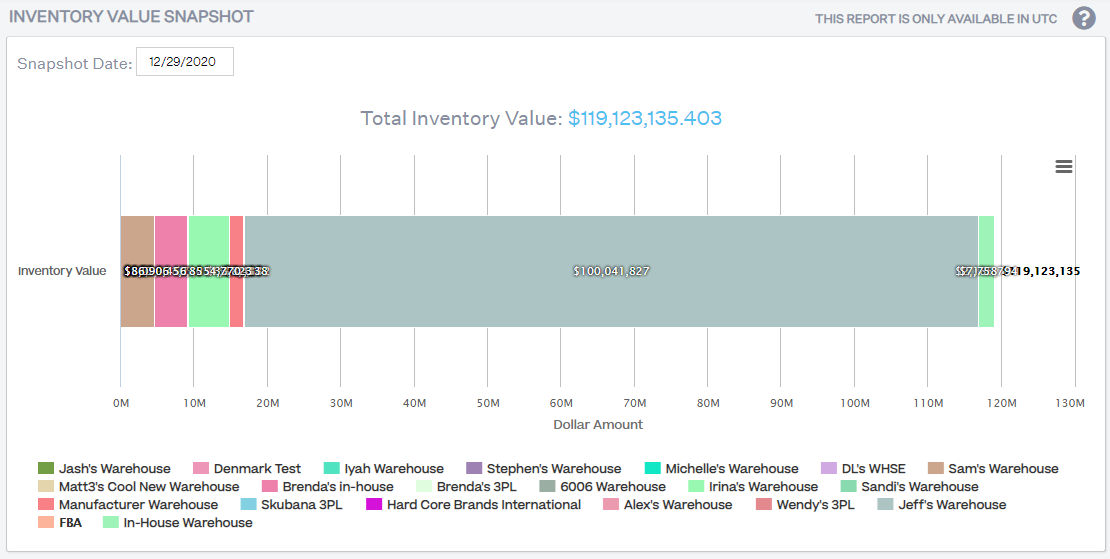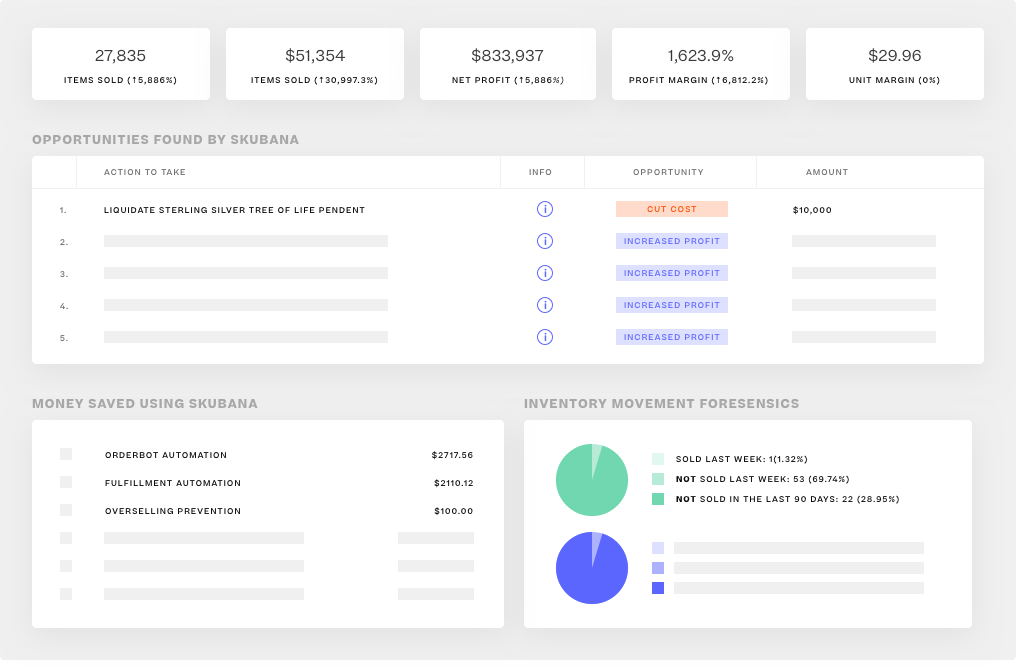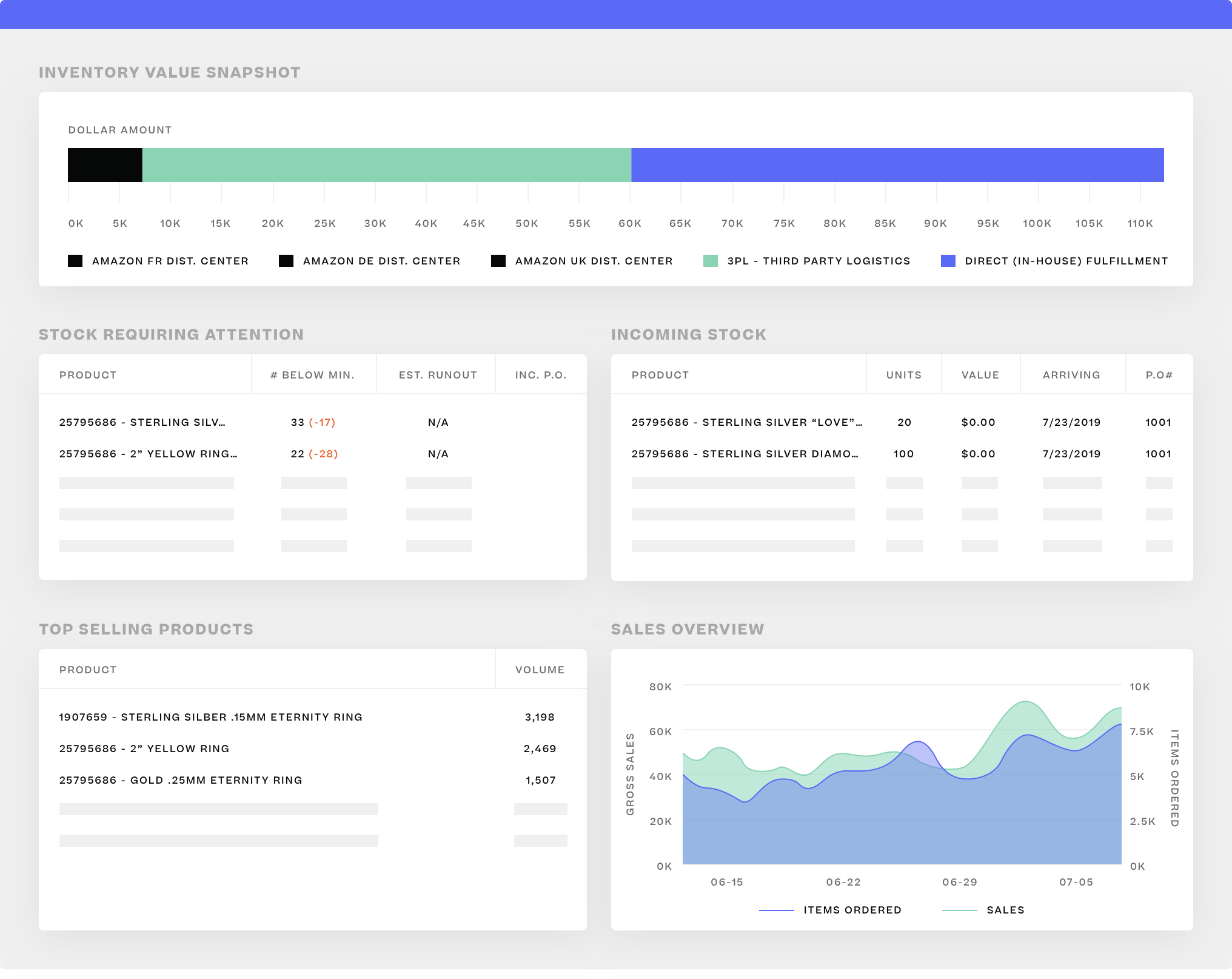Inventory management is not a new concept in the retail industry, but with an increase in the number of stores and warehouses, it has become more challenging to manage inventory across multiple locations. So how do you track inventory across multiple locations and how can you make sure your products are available at all times? These questions and many more will be answered in this blog post.
What Is Multi-Location Inventory Management?
Simply put, it's the process of managing your inventory across multiple locations. This could mean different warehouses, stores, or online marketplaces. Whatever the case, your product information and pricing should be consistent across all channels.
Pros and Cons of Multi-Location Inventory
There are many reasons to keep inventory in multiple locations. The most obvious one is that it allows you to ship packages quicker since they're not located miles away from the shipping facility. By reducing the distance traveled by each shipment, transportation charges for moving products between warehouses are eliminated.
However, moving beyond a single warehouse can be challenging because it requires reliable and seamless integration between multiple systems, Warehouse Management Systems (WMS), and other point solutions like parcel carriers or couriers. This can be challenging if your company or industry is new to ecommerce or is still growing its digital reach—especially when trying out new technologies for the first time!
Best Practices for Better Multi-Location Inventory Management
Inventory management software is helpful because it allows you to track your inventory across multiple locations in a single system. It's critical that you use an inventory management tool that allows for easy integration with other systems like ecommerce platforms and ERP systems. This will help keep all of your data accurate across all platforms so that when an order comes through on one platform—whether it be online or at a brick-and-mortar store—you know what to expect from each store's inventory levels. The better integrated your business is with its various applications and services, the smoother operations become overall.
The best practices for multi-location inventory management include:
- Using only one system for managing inventory across all locations
- Purchasing barcodes for each location/store/branch individually (rather than using one set of barcodes)
KPIs and Inventory Analytics for Multiple Warehouses
Inventory analytics are an essential part of any inventory management solution. They give you valuable data about how your inventory is performing, how much it costs, and more. Multi-location inventory management solutions often provide a variety of Key Performance Indicators (KPIs) and reports to help managers make informed decisions about their business operations. Some KPIs include:
- Inventory Analytics for multiple warehouses
- Profitability per SKU per warehouse
- Inventory value
- Inventory loading
Skubana's Snapshot value report reveals the total value of all your products at each individual warehouse and compares the volume of inventory in each warehouse. This report can help you determine which products have higher profit margins so that you can focus on them when making buying decisions or stocking orders. The snapshot value report shows what percentage of your overall inventory has been stored at each location at any given time period (monthly or quarterly).
 The trending value report shows us how many units of a specific product we've had in storage over time, so if you notice considerable growth, then it might be time to place another order with your supplier. This will also help you identify products that aren't selling well and shouldn't be stocked at all.
The trending value report shows us how many units of a specific product we've had in storage over time, so if you notice considerable growth, then it might be time to place another order with your supplier. This will also help you identify products that aren't selling well and shouldn't be stocked at all.
 Another aspect of analytics is forecasting. Since stockouts and overstocks can significantly hurt your company’s bottom line and impact the quality of customer service, it’s vital to have a strategy in place to avoid these situations and strengthen customer satisfaction at the same time. Demand forecasting software does exactly that, by delivering precise predictions for anticipated future demand. These systems make sure you always have the right amount of available SKUs, which translates to continued growth and profitability for your brand. You can set reorder points for each warehouse to maintain healthy stock levels and safety stock at each location.
Another aspect of analytics is forecasting. Since stockouts and overstocks can significantly hurt your company’s bottom line and impact the quality of customer service, it’s vital to have a strategy in place to avoid these situations and strengthen customer satisfaction at the same time. Demand forecasting software does exactly that, by delivering precise predictions for anticipated future demand. These systems make sure you always have the right amount of available SKUs, which translates to continued growth and profitability for your brand. You can set reorder points for each warehouse to maintain healthy stock levels and safety stock at each location.

Order Management with Multiple Warehouses
When you have multiple warehouses, order management becomes a bit trickier. You need to be able to manage orders across different warehouses and all their inventory levels while tracking the status of each order and its movement through the supply chain. For example, if you're using one central warehouse as a distribution point, how can you keep track of where all your products are being sent?
Extensiv Order Management (formerly Skubana) offers robust automation functionality for order management with multiple warehouses. The platform manages orders across multiple warehouses; it also allows users to create cross-dock locations so that goods can be transferred from one location (such as an incoming warehouse) to another location (such as an outgoing warehouse).
In addition to managing these transfers automatically, Extensiv's Order Management tool tracks inventory levels in each warehouse as well as movements between them. This gives managers access at every point along the supply chain so they can monitor what's happening with both their own products and those coming from suppliers or distributors within their network.
Multi-Location Inventory v. Omnichannel Fulfillment
It's helpful to understand the difference between multi-location inventory and omnichannel fulfillment strategies.
Multi-location inventory is a strategy for managing inventory across multiple warehouses. It's used to create redundancy in case one of your warehouses goes offline for some reason (e.g. natural disaster). You can also use multi-location inventory to reduce costs by having one warehouse store all your products and then another warehouse with lower overhead to handle orders from customers who live nearby.
Omnichannel fulfillment is a strategy for managing inventory across multiple channels like online shopping, mobile apps, and stores in physical locations (e.g. Walmart). This means that you need more than one distribution center—you need to manage what happens when a customer buys an item either on their computer or in person at the local Walmart store by mixing in stock from various sources so they can get what they want without having to wait too long!
How to Store Inventory with a 3PL and Your Own Warehouse
If you're interested in expanding your business into multi-location inventory management, a third-party logistics (3PL) provider can be a great asset. Instead of building and operating a second fulfillment center, which involves significant capital investment and operational resources, you can use a 3PL to ship your products to customers who are far from your first location.
A 3PL will also allow you to minimize shipping zones—which means that fewer employees need to be trained on how best to handle each product line. This helps streamline the process while simultaneously reducing costs. It's important to note that this approach isn't always possible; if there aren't enough customers within a certain radius of another location, it may not be practical for them to order from one warehouse at all times without paying extra fees for shipping services between warehouses or having large inventories on hand at each site at all times. However, when used effectively by companies with sufficient volume across multiple locations (such as retail stores or restaurants), this method can work quite well.
In addition, some third-party logistics providers offer additional benefits such as warehousing services with temperature control capabilities, something else worth considering if temperature-sensitive items make up part of your inventory.
How to Store Inventory with Amazon FBA and Your Own Warehouse
Another option you have is to store inventory with Amazon. This is a great option if you have a lot of inventory and don't want to operate your own warehouse.
Amazon FBA stands for Fulfillment by Amazon. With this service, Amazon will store your products and manage the shipping process for you so that customers can purchase from their site instead of yours. The cost of using this service depends on how many products are being stored and shipped, but it's usually around $0.60 per unit shipped (and there's no minimum). There are also chargeback fees if customers return items or refuse shipments, and these can add up quickly if they happen often enough.
Leverage Technology Like Extensiv's Order Management to Optimize Multi-Location Inventory Flow
To take advantage of the benefits of multi-location inventory management, you need to leverage technology. Software like Extensiv’s Order Management can help you manage inventory across multiple warehouses, stores, and ecommerce sites. With a cloud-based solution like Extensiv Order Management (formerly Skubana)—a software that helps businesses optimize their supply chain operations across multiple locations—you can streamline your entire operation from one centralized platform.
Extensiv Order Management allows users to manage orders in real time while also automating tasks such as order processing and warehouse operations. The system can be customized to meet the needs of each business by adding or removing features depending on their specific requirements or preferences. As a result, it puts businesses in control over every aspect of their operations without requiring an excessive amount of overhead or investment up front (which is especially beneficial when there are multiple locations).
If you're looking for ways to improve your multi-location inventory flow management process while saving costs along the way, then consider using software such as ERP systems; Warehouse Management Systems (WMS); Distribution Center Management Systems (DCMS); Asset Tracking Software; Mobile Inventory Management Apps; and Cloud-based Supply Chain Software Solutions.
Decide How to Allocate Inventory between Different Stores and Warehouses
To ensure that you have enough inventory to meet demand, you need to decide how to allocate it between your different locations and warehouses.
Carefully managing levels of inventory across a network of warehouses and/or stores is referred to as inventory allocation. This can be done manually or through automation software, which will help you make smarter decisions throughout the allocation process.
When deciding where to allocate your inventory, consider:
- If there is sufficient space at each location for additional product storage
- If there are any products that may sell better in one location over another
- Whether or not there are enough employees in each store to handle stocking duties
- How much time it would take for employees from one store/warehouse location to travel between stores/warehouses
- What type of supply chain management system (SCM) is being used by each store/warehouse (if they have one), including whether or not they have access to automated replenishment systems like Just in Time Inventory Management Systems (JIT) and Order Fulfillment Systems (OFS)
To make the best decision, you need to know how much inventory is being used in each store/warehouse location. This will help you determine if there are any products that may not sell well in certain areas. You can then relocate those products via stock transfers to places where they are more likely to sell.
Find Out if Your Stores Should Share Inventory
If you have a large inventory, it may be challenging to manage your inventory effectively. However, if you have a small inventory, then managing it can be fairly simple.
To determine whether your stores should share inventory:
- If the size of your store's current stock is larger than what will fit into a standard shipping container (about 20 pallets), then it's likely that your store could benefit from sharing its stock with other locations
- If this isn't the case and your current stock would only fill one or two shipping containers at most, then perhaps it would be best for each location to maintain its own supply of items if possible.
Pay Attention to Trends and Seasonality and Change Your Inventory Control Strategy Accordingly
If you have multiple locations, tracking and monitoring your inventory is a must. If you don't do this, then how will you know how much of each item is left? Or where it needs to be replenished? This will increase the chances that customers receive the right products when they want them.
So how can you keep track of all these items and make sure they are in stock at all times? One way is by using similar or identical items across multiple locations. For example, if one location sells black t-shirts but runs out quickly because there aren't many other options for shoppers besides red and white ones, then another location could use black shirts instead until more arrive from backorder.
Another option would be for both locations to offer both colors so customers can choose which one they want when making their purchase decisions—this way, no matter where they shop today (or tomorrow), there will always be something available!
Automate Processes That Can Be Automated
It’s a good idea to figure out which processes can be automated—common ones include creating purchase orders, receiving stock, and sending real-time updates across all your locations.
There are many time-consuming and error-prone processes that can be automated with a little effort. For example, if you receive an order from one of your locations and it needs to be fulfilled by another location with an exact inventory level at the time of fulfillment (e.g. 11 items), you can automatically send this information back as part of the purchase order creation process so that the receiving location knows how many items to expect. This way, there's no need for manual task assigning or on-site follow-up meetings when things go wrong.
Inventory management software is a great solution for automating complex multi-location supply chains because it allows you to easily create workflows between different departments within each store or business unit because you can:
- Link data points together, such as order details with inventory levels
- Provide real-time visibility into business performance indicators
- Control permissions on who can make changes
- Track costs against vendor quotes or purchases made by each individual employee
- Automate pricing structures based on demand spikes during promotional periods
- Generate powerful reports across multiple dimensions (e.g. product prices over time/region sold through channels), which helps identify trends in customer behavior patterns before they reach their peak and without compromising security or privacy regulations
Interlink with Others' Inventory Management Systems to Streamline Your Processes
You can significantly improve your supply chain by using an inventory management system that allows you to track, monitor, and communicate with others' inventory management systems. This will help ensure that all parties involved in the transaction have access to the same information at all times.
You should make sure that you have a data-sharing agreement in place with your suppliers before connecting their systems with yours. You will also need to set up a communication process so that when any changes take place within one of your locations, they can be automatically reflected in all other locations as well.
Improve Your Multi-Location Inventory Management by Following These Tips
- Use the right tools for the job. You can use a variety of inventory management systems to help you manage your inventory across multiple locations, but it's important that you choose one that works best for you.
- Be consistent with your inventory management processes. One of the easiest ways to improve your multi-location inventory management is by being consistent with your processes and making sure everyone is always doing things the same way, so there aren't any issues later down the line.
How Do You Track Inventory across Multiple Locations?
You have a lot on your plate. You're trying to grow your business, but it isn't easy with so much to manage. That's where we come in.
When you sell products through multiple locations, there are a few ways that you can keep track of inventory across locations, but there are also some drawbacks that can make this process confusing and time-consuming.
The best way for you to manage inventory across multiple warehouses is by using a platform like Extensiv Warehouse Management since it allows for seamless integration with other services such as Shopify, Amazon, Walmart, and other marketplaces. This way you'll be able to easily view key metrics on sales and inventory from one place without having to switch between programs repeatedly.
What Are the Benefits of Having Inventory across Multiple Locations?
By having multiple stores, you can reduce your inventory costs and increase sales. When you have centralized control over all your inventory, it is easier to manage it effectively across multiple locations. When one store runs out of a product, the software will help determine how much inventory needs to be transferred from another store.
This improves customer satisfaction by ensuring that they always get what they want when they want it. It also helps improve profits because fewer items will sit on shelves or in back rooms unsold for long periods of time. If a product does not sell well at one location, then it can be sold at another location where there may be more demand.
What Is the Best Tool for Managing Inventory across Multiple Warehouses?
The best tool for managing inventory across multiple warehouses is Extensiv Warehouse Management (formerly Skubana).
Inventory management can be extremely complicated, with many different moving parts. There are several reasons why it's important to track your inventory across multiple locations:
- You can save money on shipping costs by shipping out orders from the closest warehouse
- You can avoid long delivery times by sending products directly to the customer from the nearest location rather than having them make several stops on their way to the customer's house or business
- You may get better deals on bulk purchases if you have access to more than one warehouse
Conclusion
Multi-location inventory management is a great way to help your business grow. With the right tools and processes in place, it's easy to manage multiple warehouses with minimal effort on your part. The key is knowing how much inventory you need at each location and when it needs to be replenished. It can take some time for businesses to transition to multi-location inventory management, but once they have all the pieces in place, their operations will run smoothly without any problems!
-
You’ll read about:
Be the first to know
Subscribe to our newsletter





